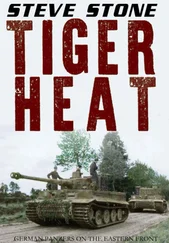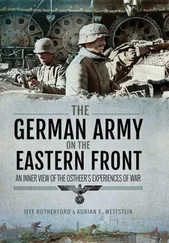Generaloberst Guderian’s Panzergruppe 2 (Heeresgruppe Mitte)
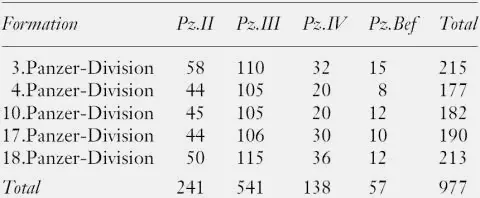
Generaloberst Hoth’s Panzergruppe 3 (Heeresgruppe Mitte)
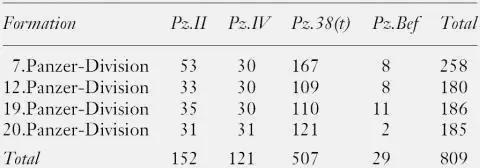
Generaloberst Höpner’s Panzergruppe 4, which was tasked to support Heeresgruppe Nord’s advance toward Leningrad, was the smallest German armoured formation given an independent mission in Barbarossa. Höpner had three panzer divisions, comprising eight panzer battalions with 590 tanks. His panzer units were all veteran outfits, but equipped with a motley collection of German and Czech-made tanks. In particular, the 6.Panzer-Division was primarily equipped with obsolescent Czech Pz.35(t) light tanks, which had no spare parts available even at the start of the campaign. The Czech Pz.35(t) was not mechanically reliable enough for a protracted campaign and none would remain in front-line combat service after October 1941. The 1.Panzer-Division was particularly fortunate in having two out of its four Schützen Abteilung (rifle battalions) equipped with a total of nearly 200 Sd.Kfz.250 and Sd.Kfz.251 half tracks.
In southern Poland, Generaloberst von Kleist’s Panzergruppe 1 was assembled to spearhead Heeresgruppe Süd’s advance toward Kiev. Kleist was given the second-best equipped Panzergruppe after Guderian, with ten panzer battalions in five panzer divisions, with a total of 730 tanks. Kleist’s command had no Czech-built tanks and a good number of Pz.III medium tanks, but he also had significantly more ground to cover in his objectives than the other Panzergruppen. Abwehr intelligence estimates on Soviet tank strength and dispositions were poor, but sufficient to indicate that Kleist would be up against some of the strongest formations available to the Red Army. Thus, it would come as little surprise that Kleist would need help from at least one other Panzergruppe to complete his mission.
Generaloberst Höpner’s Panzergruppe 4 (Heeresgruppe Nord)

Generaloberst von Kleist’s Panzergruppe 1 (Heeresgruppe Süd)
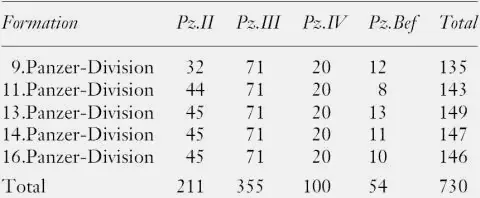
The main combat elements of the 1941 Panzer Division were a panzer regiment (some divisions still had panzer brigade headquarters) with two or three panzer battalions; two Schützen (motorized infantry regiments) with a total of four battalions; a Kradschützen battalion (motorcycle infantry); an Aufklärungs Abteilung (reconnaissance battalion); a motorized artillery regiment with a total of thirty-six towed howitzers; a Panzerjäger Abteilung with towed 3.7cm and 5cm Pak guns and a motorized pioneer battalion. Most of the infantry rode in trucks, but panzer divisions were beginning to receive the excellent Sd.Kfz.250 and Sd.Kfz.251 half tracks; about 560 were available at the outset of Barbarossa. Altogether, the panzer division was authorized a total of 5,300 infantry in the five Schützen and Kradschützen battalions. A 1941 panzer division had a total of about 4,100 vehicles. The organization of a Panzer Abteilung (battalion) was far from standardized in June 1941, but its combat elements were authorized two or three light companies (equipped with Pz.III, Pz.35(t) or Pz.38(t)) and one medium company with Pz.IVs. All told, an ideal, full-strength Panzer Abteilung would have between sixty-six and eighty-eight tanks (fifteen to twenty Pz.II, thirty-five to fifty-two Pz.III, fourteen Pz.IV, two Pz.Bef) and 625–780 men. [3]Although a number of obsolete Pz.I light tanks were still in the panzer division, they were not in the panzer regiments but in the panzer pionier-bataillon , where they served as mine-clearing vehicles.
Major sub-units in the Panzer Division
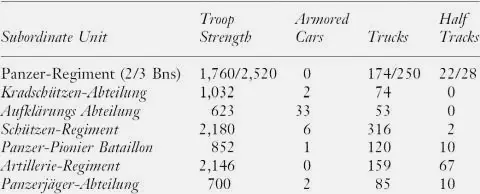
The main German battle tank employed in Operation Barbarossa was the Pz.III, with the newer Ausf G and H models representing the best available to the Panzerwaffe at that time. These models, both armed with the 5cm KwK 38 L/42 cannon, were better in terms of firepower and protection than the T-26 or BT-series light tanks which still comprised the bulk of the Red Army’s tank forces. The Pz.III was intended to defeat enemy tanks and carried a typical basic load of eighty-five armour-piercing and fifteen high-explosive rounds. The standard 5cm Panzergranate 39 armour-piercing round could penetrate up to 47mm of armour at 500 meters, enabling the Pz.III Ausf G or H to defeat all Soviet light tanks at typical battlefield ranges. The Pz.III would even be able to inflict damage on the Soviet T-34, using Panzergranate 38 with flank or rear shots fired from ranges under 500 meters; difficult, but not impossible. The 5cm Panzergranate 40, which had much better armour-piercing capability due to its tungsten penetrator, entered production just before the start of Barbarossa and was available only in limited numbers; for example, Panzergruppe 4 had enough Panzergranate 40 available to equip each Pz.III with just five rounds. [4]While the Pz.III’s antiarmour firepower was modest, its main limitation was its tactical range of barely 100km on a single load of fuel, which was not very impressive.
The Pz.IV medium tanks, armed with the 7.5cm KwK 37 L/24 howitzer, were armed with a mix of fifty-two high explosive rounds, twenty-one armour-piercing rounds (k.Gr.rot.Pz. (APC) or Panzergranate) and seven smoke rounds at the start of Barbarossa. [5]While the 7.5cm k.Gr.rot.Pz. round could penetrate up to 39mm of armour at 500 meters, its low velocity made it poorly-suited for anti-tank combat against T-34 or KV tanks. In an effort to improve firepower, the Germans were developing a new type of High Explosive Anti-Tank (HEAT) rounds for the 7.5cm howitzers on Pz.IVs and StuG III assault guns, but they would not be available until the end of 1941. In actuality, both the Pz.IV and StuG III were only suited for the infantry support role in 1941, leaving the Pz.III as the sole effective dual-purpose tank employed by the Panzerwaffe in Barbarossa. In addition to the panzers, the Wehrmacht deployed twelve Sturmgeschütz-Abteilung with over 200 StuG III assault guns and five Army-Level Panzerjäger-Abteilung equipped with 135 Panzerjäger I tank destroyers. The Panzerjäger I was an improvisation, with the high-velocity Czech-made 4.7cm cannon mounted atop an obsolete Pz.I chassis; the 4.7cm was one of the best anti-tank weapons available to the Wehrmacht at the start of Barbarossa.
Nearly one-quarter of the German battle tanks heading into the Soviet Union were Pz.II light tanks, which were already obsolescent in the previous French campaign. Unlike the Pz.I, the Pz.II still played a major role in German tank platoons and companies. Although often used as a scouting tank, the Pz.II tank had better armoured protection than either the T-26 or BT-series light tanks and its rapid-firing 2cm KwK 30 cannon could penetrate their armour at ranges under 500 meters. The Pz.II would also play a useful role in escorting supply convoys through forested areas infested with Soviet partisans.
Despite much media publicity about Germany’s so-called Blitzkrieg doctrine both during and after the war – which was intended to create the impression of short, successful campaigns – the Panzerwaffe had a relatively amorphous doctrine in 1941. One of the key components of this doctrine was a preference for combined-arms tactics in mixed kampfgruppen; tank-pure tactics were rejected as foolhardy and inefficient. As an example, the 4.Panzer-Division’s Kampfgruppe Eberbach in early July 1941 was comprised of one Panzer-Abteilung , one Kradschützen Kompanie (motorcycle infantry), a Schützen Kompanie (Mechanized Infantry) in SPW half tracks, an artillery battalion (twelve towed 10.5-cm howitzers), two Pioneer Kompanie , part of a Brückenkolonne , one heavy flak battery (8.8cm) and one light flak battery (2cm). All told, Kampfgruppe Eberbach started with about 2,300 troops and 750 vehicles. Other variations included Panzerjäger and Aufklärungs (reconnaissance troops), as well as more infantry. Each panzer division would normally form three kampfgruppen, usually one that was tank-heavy and two that were infantry-heavy.
Читать дальше







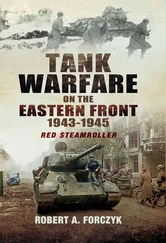
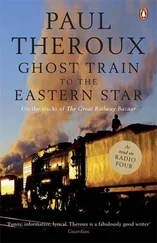



![John Stieber - Against the Odds - Survival on the Russian Front 1944-1945 [2nd Edition]](/books/405234/john-stieber-against-the-odds-survival-on-the-russian-front-1944-1945-2nd-edition-thumb.webp)
